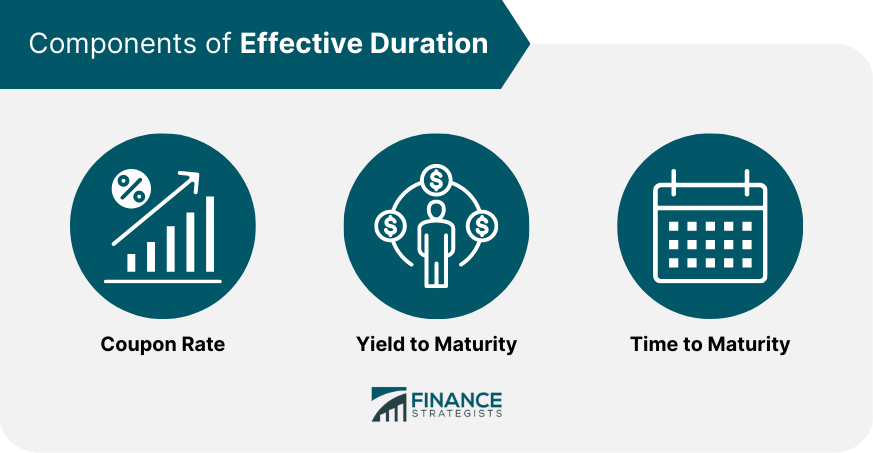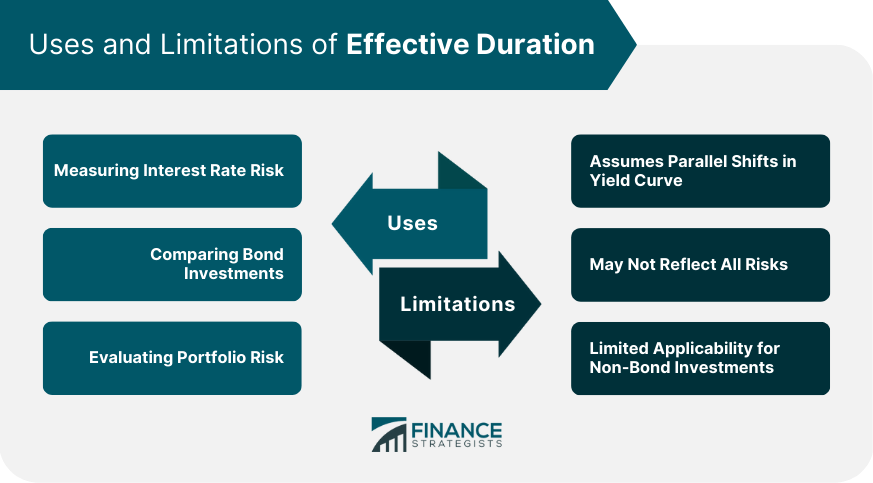Effective duration is a measure of the sensitivity of a bond's price to changes in interest rates. It takes into account the impact of changes in interest rates on a bond's cash flows, including the effect of changes in the bond's yield to maturity and the timing and size of coupon payments. Effective duration is a fundamental concept in finance and investment, which enables investors to assess potential risks and losses. It is especially significant for investors who aim to maximize returns while managing risk. By utilizing effective duration, investors can identify possible negative risks and make informed decisions on asset allocation, risk management, and investment strategies. Furthermore, effective duration is a crucial measure in evaluating the performance of bond funds or investment managers as it reflects the degree of exposure to interest rate fluctuations. Through comprehending effective duration, investors can evaluate potential risks associated with an investment or portfolio and make well-informed decisions. The duration of a bond can be calculated by taking the weighted average of the present value of its cash flows, where the weights are the proportion of the present value of each cash flow to the total present value of all the cash flows. The duration of a bond is directly related to changes in interest rates. The longer the duration, the more sensitive the bond's price is to changes in interest rates. This is because longer-duration bonds have more future cash flows, which are subject to greater uncertainty about future interest rates. Effective duration is a measure of the sensitivity of a bond's price to changes in interest rates, taking into account the impact of changes in the bond's yield to maturity and the timing and size of coupon payments. Effective duration is determined by three key components: Coupon Rate: The higher the coupon rate, the shorter the effective duration, as coupon payments are received sooner and are less impacted by changes in interest rates. Yield to Maturity: The higher the yield to maturity, the shorter the effective duration, as the impact of changes in interest rates on the bond's price is less significant. Time to Maturity: The longer the time to maturity, the longer the effective duration, as the bond's future cash flows are subject to greater uncertainty about future interest rates. Effective Duration is important for various reasons and uses, including the following. Effective duration is an important tool for measuring interest rate risk in bond investments and portfolios. By understanding the potential effective duration risk associated with an investment, investors can make informed decisions about asset allocation and risk management strategies. Effective duration can also be used to compare the interest rate risk of different bond investments. By comparing the effective duration of different bonds, investors can evaluate the potential risk and return of each investment and make informed decisions about their investment portfolios. Effective duration is also an essential measure for evaluating the interest rate risk of a bond portfolio. By understanding the effective duration of a portfolio, investors can assess the potential risk associated with changes in interest rates and make informed decisions about portfolio construction and risk management strategies. There are several limitations involved in effective duration. Effective duration assumes that changes in interest rates are parallel across the yield curve. However, in reality, changes in interest rates may not be parallel across the yield curve, which can impact the accuracy of the effective duration measure. Therefore, investors should consider the limitations of effective duration and use it in conjunction with other measures of risk. Effective duration does not reflect all the risks associated with a bond investment, such as credit risk or liquidity risk. Therefore, investors should consider the potential impact of other risks on their investment portfolio. Effective duration is primarily applicable to bond investments and may not be relevant for other types of investments, such as equities or real estate. Therefore, investors should consider other measures of risk for these types of investments. Below are some details on how effective duration can be managed. Effective duration plays an important role in risk management, helping investors identify potential interest rate risks and make informed decisions about asset allocation and risk management strategies. By understanding the effective duration of an investment or portfolio, investors can manage potential risks effectively. Effective duration limits and guidelines can be used to manage risk and minimize potential losses. For example, investors may set a maximum effective duration limit for their portfolio, beyond which they will reduce their exposure to longer-duration bonds. Hedging strategies, such as interest rate swaps or options contracts, can also be used to manage effective duration risk. For example, interest rate swaps can be used to manage the interest rate risk of a bond portfolio by exchanging fixed-rate cash flows for variable-rate cash flows. Effective duration is an essential concept in finance and investment, providing a measure of potential risk and loss. It is important for investors to understand effective duration and its implications for investment decision-making and risk management. Effective duration can inform investment decision-making, asset allocation, and risk management strategies. By understanding effective duration, investors can make informed decisions about their investment portfolios and manage potential risks effectively. There are many potential areas for further study in the field of effective duration. For example, future research could explore the impact of effective duration on different bond sectors, the effectiveness of different risk management strategies, and the role of effective duration in behavioral finance.Definition of Effective Duration
How Effective Duration Works
Components of Effective Duration

Uses of Effective Duration
Measures Interest Rate Risk
Compares Bond Investments
Evaluates Portfolio Risk
Limitations of Effective Duration
Assumes Parallel Shifts in Yield Curve
May Not Reflect All Risks
Limited Applicability for Non-Bond Investments

Effective Duration and Risk Management
Role of Effective Duration in Risk Management
Effective Duration Limits and Guidelines
Hedging Strategies for Effective Duration Risk
Final Thoughts
Effective Duration FAQs
Effective duration is a measure of a bond or portfolio's sensitivity to changes in interest rates.
Effective duration is calculated by estimating the expected percentage change in a bond's or portfolio's price for a given change in interest rates.
The components of effective duration include the bond's or portfolio's coupon rate, time to maturity, and yield to maturity.
Effective duration assumes that interest rates change uniformly across all maturities and that the bond's or portfolio's cash flows do not change in response to interest rate changes.
Effective duration can be used to assess the risk and return characteristics of a bond or portfolio, and to compare different bonds or portfolios with each other. It can also help investors to manage interest rate risk.
True Tamplin is a published author, public speaker, CEO of UpDigital, and founder of Finance Strategists.
True is a Certified Educator in Personal Finance (CEPF®), author of The Handy Financial Ratios Guide, a member of the Society for Advancing Business Editing and Writing, contributes to his financial education site, Finance Strategists, and has spoken to various financial communities such as the CFA Institute, as well as university students like his Alma mater, Biola University, where he received a bachelor of science in business and data analytics.
To learn more about True, visit his personal website or view his author profiles on Amazon, Nasdaq and Forbes.















